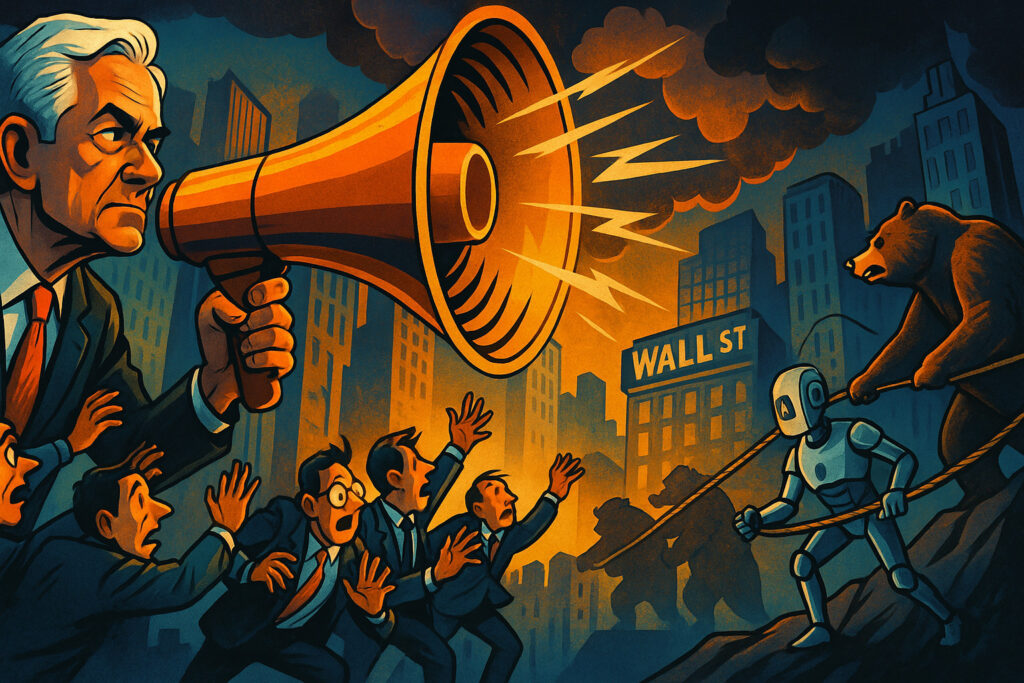Introduction
On 23 September 2025, equity markets took a step back from recent highs. Stocks retreated across the board after a tech-led rally ran into headwinds and Federal Reserve Chair Jerome Powell issued a caution: there is “no risk-free path” to simultaneously sustaining full employment and price stability. The S&P 500 fell about 0.6%, the Nasdaq plunged roughly 0.9%, and the Dow slipped 0.2%. Markets had opened with fresh intraday records, but rapidly conceded ground. The tech sector—once the engine of September’s blowoff rally—led the decline. Meanwhile, safe havens found renewed demand: gold surged to record highs, and long-dated yields ticked higher.
This was more than a pullback: it felt like a reality check. Investors paused to reconsider valuations, growth assumptions, and the delicate balance between easing hopes and inflation risks.
Body
A Day of Reversal: From Records to Retreat
The session began with optimism. The S&P 500 hit a new intraday high before rolling over. The Dow logged a modest intraday peak, and the Nasdaq briefly flirted with fresh records. But by the close, the mood shifted decisively: tech weakness spread, raising questions about whether the recent rally had overextended itself.
In terms of numbers:
- S&P 500 dropped ~0.6%
- Nasdaq lost ~0.9%
- Dow declined ~0.2% These moves reflected broad selling pressure, with tech names bearing the brunt of the reversal.
Powell’s Tone Shakes Confidence
Federal Reserve Chair Jerome Powell delivered his first public comments since the rate cut, and his tone was measured, sober, and cautionary. He emphasized that while easing is underway, risks remain—especially with valuations and inflation expectations elevated. His quote, “there is no risk-free path,” resonated deeply; markets interpreted it as a warning that cuts would be conditional, not carte blanche.
Investors digested that message with trepidation. The idea of a future easing cycle remained intact, but Powell’s guardrails and cautionary framing introduced doubt into what had been a near-unstoppable optimism.
Tech Pulls Back
Tech led the decline. After powering the recent rally, mega-cap names like Nvidia and Amazon reversed sharply, dragging the Nasdaq downward. The tech sector had run far and fast; the reversal on 23 September felt more than a correction—it felt like profit-taking.
Semiconductors, cloud infrastructure, AI players, and high-multiple software names all saw weakness. The decline exposed the fragility of a rally heavily concentrated in growth, especially when narratives shift from “cut cycle” to data dependency and central bank vigilance.
Yields and Bonds: A Renewed Jolt
Treasury markets reacted to Powell’s remarks. Yields ticked upward again, especially on the long end. The yield curve flattened further, and bond investors signaled renewed skepticism about how far the rally could go without inflation reasserting itself.
The “steepening yield curve warning” also surfaced: long-dated bond yields, already under pressure this summer, are now flashing signals of strain. For dividend discount models and growth valuations, higher discount rates are no trivial matter.
In short: bond markets were not buying the full optimism. They remained a counterbalance, reminding investors that easing is not frictionless.
Gold’s Resurgence
Amid equity weakness and yield pressure, gold surged to a new record high. As stocks wavered, safe-haven demand reasserted itself. Gold’s rise underscored that despite the equity exuberance, many investors remain hedged, alert to risk.
Gold’s strength on this day was a signal: the rally’s path is not unchallenged; uncertainty waits in the shadows.
Global and Macro Context
Internationally, markets were mixed. U.S. equity weakness spilled into European equities, dampening sentiment there. In Asia, Chinese equities rallied after the PBoC held rates steady, offering some relief in the region. But global growth signals remain tentative.
From a macro standpoint, business activity surveys were cooling, supply chain pressures easing, and inflation dynamics showing divergent trends. The decline in global commodity markets (except gold) added another dimension: demand concerns are not fully resolved.
The backdrop suggested markets may be entering a transition phase: from runaway optimism to selective, discerning advances.
Conclusion
23 September 2025 marked a turning point. The rally paused, symbols of overextension sputtered, and Powell’s careful words cast a long shadow. The day was not catastrophic—but it was necessary.
Markets now confront a new challenge: can optimism survive without overreach?
Key Questions Ahead
- Will Powell’s caution dampen expectations for further cuts, or is this just recalibration?
- Can tech leadership rebound, or will rotation toward value and defensives accelerate?
- Will rising yields and inflation fears derail valuation-heavy sectors?
- Will gold continue to rise as markets hedge against policy missteps?
This day may not be a peak, but it is a pivot: the rally paused, and markets began to judge claims by both earnings and risk.
